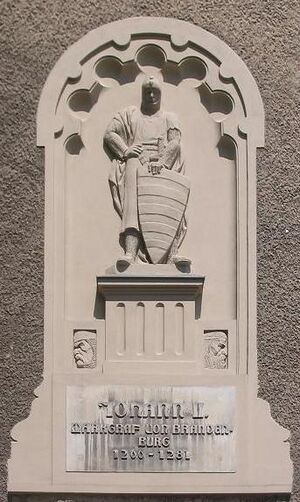John II, Margrave of Brandenburg-Stendal facts for kids
Quick facts for kids John II, Margrave of Brandenburg-Stendal |
|
|---|---|

Paten depicting John II and his wife, Hedwig of Werle, from the Chorin Abbey, 1280/1290
|
|
| Born | 1237 |
| Died | 10 September 1281 |
| Spouse | Hedwig of Werle |
| House | House of Ascania |
| Father | John I, Margrave of Brandenburg |
| Mother | Sophie of Denmark |
John II, Margrave of Brandenburg-Stendal (born 1237 – died 10 September 1281) was an important ruler in the Margraviate of Brandenburg. He shared power with his brother, Otto "with the arrow", from 1266 until he passed away. John II also held the title Lord of Krossen, which was a town in the area known as the Neumark.
Contents
Life of John II
Sharing Power in Brandenburg
John II was part of the House of Ascania, a powerful family that ruled Brandenburg. He was the oldest son of Margrave John I and his first wife, Sophie of Denmark. Sophie was the daughter of King Valdemar II of Denmark.
Because John II shared his rule and was not always in the spotlight like his brother Otto IV, we don't know as much about him. However, he did sign an important agreement called the Treaty of Arnswalde in 1269 with Duke Mestwin II. John II was one of only two co-rulers from his time to have a statue made of him on the Siegesallee in Berlin.
Chorin Abbey and Royal Burials
Much of what we know about John II is connected to Chorin Abbey. This was a Cistercian monastery, a type of religious community, that his father founded in 1258. It was first called Mariensee. His father wanted the Margraves of Brandenburg-Stendal to be buried there. This was because the older burial place, Lehnin Abbey, was in a different part of Brandenburg.
Castles and Hunting Grounds
In 1273, John II and his brothers, Otto IV and Conrad I, made a joint statement. They confirmed that the Mariensee monastery would be moved to Chorin. Their official seals showed a picture of an armed Margrave with an eagle on his shield. Each seal had a different name, showing which brother it belonged to.
This important document was signed at the castle in Werbellin. Werbellin is a village in the Schorfheide area. In the 1200s, the Schorfheide was a favorite hunting spot for the Ascanian rulers. They had three castles in this large forest. Otto IV liked Grimnitz Castle. John II preferred the fortified house at Breden and the castle in Werbellin.
All three castles were built by John I. They were likely destroyed in the 1300s. You can still see some ruins of Grimnitz Castle today. On the hill where Werbellin castle once stood, there is now an observation tower. This tower was opened in 1879 to remember the Ascanian family.
John II was buried at Chorin Abbey in 1281. His wife, Hedwig, was buried there in 1287. The abbey was still being built when they were laid to rest.
Family Life
Between 1258 and 1262, John II married Hedwig of Werle. She was born in 1243 and passed away in 1287. Hedwig was the daughter of Nicholas I of Werle.
John II and Hedwig had two sons:
- Conrad II (1261–1308)
- John (1263–1292), who became a Bishop of Havelberg
Statue on the Siegesallee
John II's statue is part of a collection of statues on the Siegesallee in Berlin. This collection was created by Kaiser Wilhelm II. Even though John II was a co-ruler and not as famous as some others, his statue was included. It helped complete the design, which needed a certain number of statues on both sides of the avenue.
The statue of John II was made by a sculptor named Reinhold Felderhoff. There were no pictures of John II from his time, so Felderhoff had to imagine what he looked like. Old writings described John II as small but strong. However, all the statues on the Siegesallee had to be the same height.
Felderhoff decided to create a statue that looked like a quiet and serious warrior. The warrior in the statue looks down and leans on a large shield. This shield shows the symbols of the House of Ballenstedt, which is the family that the House of Ascania came from.

John II's statue group was officially shown to the public on November 14, 1900. For many years, the statue was kept in a special place called the Lapidarium in Kreuzberg. Since 2009, you can see it at the Spandau Citadel. There is also a relief (a type of sculpture that sticks out from a flat surface) based on Felderhoff's statue. It was made in 1909 and can be found in the Berlin district of Mariendorf.



